
|   |

|   |
Shinjan's Odissi Festival 2018 - Tapati Chowdurie e-mail: tapatichow@yahoo.co.in Photos: Shankar Sen June 25, 2018 Odissi Festival 2018 presented by Shinjan Nrityalaya and Dept. of Culture, Govt. of India, was a four day festival from June 8 held at Sculpture Court and Satyajit Ray Auditorium ICCR, Kolkata in honour of Kavi Chandra Kalicharan Pattnaik. Governor of West Bengal, Keshari Nath Tripathi, inaugurated the festival. It was a neatly packaged and arranged festival, which undertook an overall scenario of the Odissi firmament as it is today. What was remarkable was that on all the days of the festival, young and promising aspirants performing the learnt choreographic works of their gurus and mentors were featured when the evening was young, while veterans, with their creative choreographic works came later to regale the audience. Urjjasee Basak, a dancer with potential and recipient of CCRT scholarship from Govt. of India, performed a pallavi based on raag Behag and taal ektaali composed by Guru Kelucharan Mohapatra. Trained by Jhelum Paranjape in Mumbai, Ankur Balal who works as an assistant choreographer to his guru at Smitalay, performed Shiv Tandav Strotra describing Shiva's power and beauty. The stotra is traditionally attributed to Ravana, the demon King of Lanka, who was a devotee of Shiva. The stotra's alliterative verses as well as onomatopoeia were suitably translated into dance. It was a Pt Bhubaneshwar Mishra composition choreographed by Guru Kelucharan Mohapatra set to raag Bibhas and taal khemta. 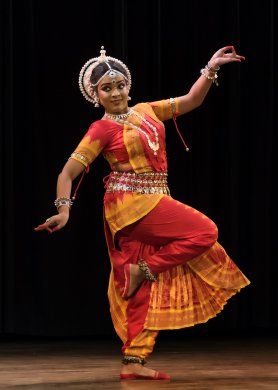 Urjjasee Basak 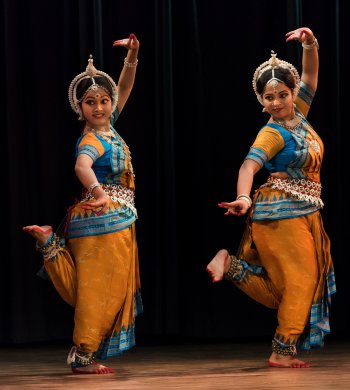 Paulomi Chakraborty and Suvra Maity 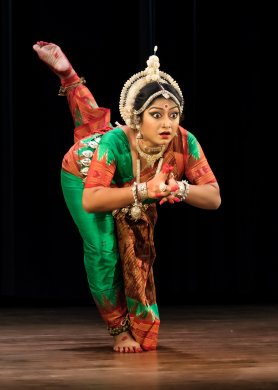 Debarati Goswami 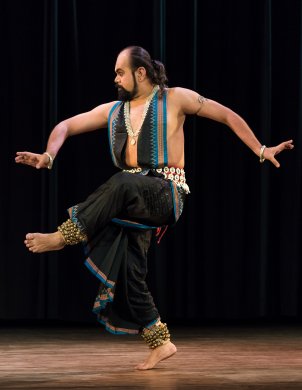 Ankur Balal Shinjan's Paulomi Chakraborty and Suvra Maity performed Taal Madhuri in duet, an Aloka Kanungo choreographic piece in taal ektaali and raag Shankarabaranam. They are being shaped up by their guru to be fine dancers. The audience was next treated to an abhinaya piece "Kede chanda janelo sahi" by Debarati Goswami, a piece by the inimitable Kelubabu in Mishra Pilu and taal rupak, which had the unmistakable stamp of the music composer Pt Bhubaneswar Mishra. She learnt Odissi from Gurus Sukanta Chowdhury, Muralidhar Majhi, Arundhati Roy, Sujata Mohapatra and presently she is under Aloka Kanungo. Sonali Mohapatra, a recipient of Bismillah Khan Yuva Puraskar, has overcome her tough challenge against hearing impairment to regale audiences wherever she has performed. Trained under Guru Truptimayee Mohanty and Guru Durga Charan Ranbir, the rasikas enjoyed the abhinaya piece "Kede chanda janelo sahi" by medieval poet Banamali in the Deba Prasad style of Odissi. She also performed Vrindavanleela consisting of Bakasuravadh, Pootanavadh, and exhibited the universe inside Krishna's mouth, besides exposing the rasikas to his other supernatural acts. Talented Ashmita Mohanty, a disciple of Aloka Kanungo, performed Pallavi in raag Shankarabaranam, a masterpiece of Guru Kelucharan Mohapatra in taal ektaali. Rahul Varshney's dance spoke for itself. A promising performer of Guru Deba Prasad Das style, meticulously nurtured by Jyoti Srivastava and Guru Durga Charan Ranbir as well as Ramli Ibrahim, he essayed through Kalavati Pallavi in taal ektaali choreographed by late guru Srinath Rout, with lyrical and fluid beauty. Rahul is a founder, artistic director of SOCH (School of Creative Hands) Delhi, a pioneer institute imparting training in different art fields. Among the younger generation of dancers, he is scaling new heights. Rajashree Praharaj is a dancer who has mastered the Odissi idiom of Kelubabu gharana under the able guidance of Guru Ratikant Mohapatra in Srjan. Recipient of a Gold Medal for Masters Degree in music from Utkal University of Culture, at present she is the senior faculty member at Srjan. Rajashree was an epitome of perfection in her neatly packaged rendition starting with paying her obeisance to her guru as well as in her rendition of Bhagavati shlokam to the music composition of Satyabrata Pathak and dance choreography of Guru Kelucharan Mohapatra with a few appropriate changes by Guru Ratikant Mohapatra. The enactment of the different activities of Devi slaying the evil forces as well as her kind acts towards the good was convincingly portrayed. Body control and balance has been fine tuned, there was not a flaw in any of the static postures or in movement. Hard work has earned rich dividends. 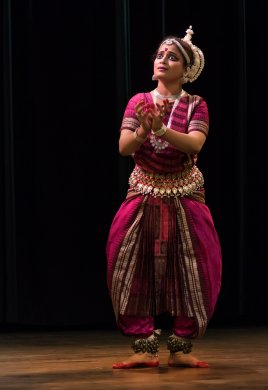 Sonali Mohapatra 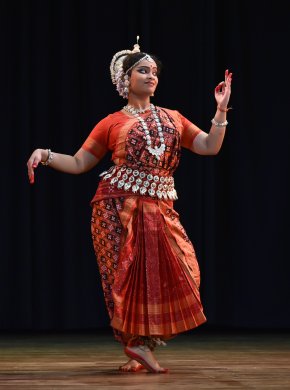 Ashmita Mohanty 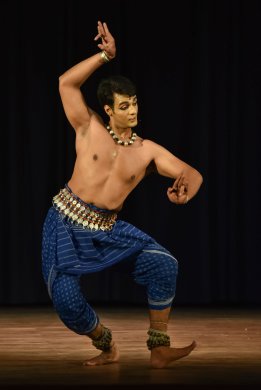 Rahul Varshney 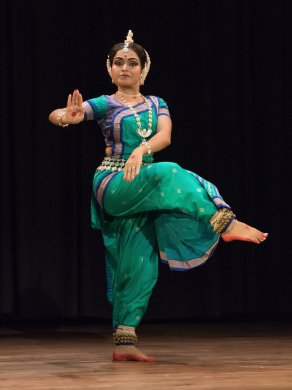 Rajashree Praharaj Swaralipi Roy performed Mahavidya in Ragamalika and Talamalika, a choreographic work of her guru Aloka Kanungo with music and rhythm by Ramahari Das and Dhaneswar Swain respectively. Maumita Dutta, who has performed in many festivals and earned the title of Prativa, performed Yog pallavi in taal ekataali choreographed by Arpita Venkatesh, a senior disciple of Aloka Kanungo to a composition of Himangshu Shekhar Swain, the rhythm of which was composed by Budhanath Swain. Arpita Venkatesh's work was remarkable; more so because the dancer was able to translate the pallavi in painstakingly acquired Odissi stances.
Solo performer Lucky Pragyan Mohanty, a disciple of Guru Kumkum Mohanty, is a vibrant performer. Trained in Kala Vikash Kendra under the tutelage of many eminent Odissi dance gurus, he was the master trainer and chief consultant to prepare Odissi dance CDs for the 45000 Government Primary Schools at Chhattisgarh. Hungry to chisel out an independent career in Odissi, he is back in Odisha. He performed "Ki sobha go kunje" of Kumkum Mohanty, with music by Pt Bhubaneswar Mishra and rhythm by Sachidanand Das. It speaks of the sakhis who are delighted to see both Radha and Krishna in Kunjabana. The sakhis are awestruck by the beauty of the pair and are all praise for it. The finer nuances of the feelings of the joyful mood of the sakhis were captured in full measure. New Delhi based Guru Ranjana Gauhar's students Vrinda Chadda, Vinod Kevin Bachan, Ankita Bakshi and Ishani Nag created an instant rapport with the rasikas welcoming them with lit lamps. The catchy tune of "Swagatham suva swagatham" to the accompaniment of dance was aesthetically beautiful, rather ritualistic with the blowing of the conch shell in the end. An ambience was created right away for what was to follow. A pure dance piece by the students was no less worthy, while the abhinaya piece, ashtapadi "Rati sukha saare" performed by Ranjana Gauhar herself was sensitively portrayed. The Sakhi who takes on the role of the guru pointing out to Radha of her preparedness to unite with the supernatural being free from all earthly objects that bind - including her clothes and ornaments and ankle bells, in what seemed to be a physical union, but actually portraying the merging of the individual soul with the supernatural soul was the highest fruit of devotion sensuously enacted. Bangalore based Sharmila Mukerjee is a successful Odissi dancer and her dance school Sanjali is a name to reckon with. Her intense search to give a fresh look at mythological characters drew her to the character of Kaikeyi, wife of Dasaratha and mother of Bharata, in the epic Ramayana. She reinterpreted the traditional portrayal of Kaikeyi who is painted as a dark character responsible for all the woes that befell Rama, soon to be anointed king of Ayodhya. What meets the eye as Kaikeyi having a flawed character may not be so. Kaikeyi's character traits are laid bare for the discerning to see her point of view. A strong willed and determined person of merit, her character is multi-layered. Her warm hearted and loving nature and her happiness in Rama's imminent coronation were portrayed well. The advice of Manthara unfortunately did not augur well for Ayodhya. As fate would have it, she took a wrong decision. Kaikeyi's reminiscing of the past through a series of flashbacks from specific episodes of Ramayana, was a gripping tale tellingly retold. The costume in the solo performance has been carefully chosen to reflect the times and the setting of the epic. Pt Nityananda Mishra's powerful script brought alive episodes from the Ramayana which has so far not been highlighted - Kaikeyi as the charioteer of king Dasaratha; his losing of a battle; the chariot getting stuck and Kaikeyi releasing it. Music composition of Bijoy Jena, rhythm composition by Dhaneswar Swain, and the choreography by Sharmila Mukerjee has given the presentation a new dimension. 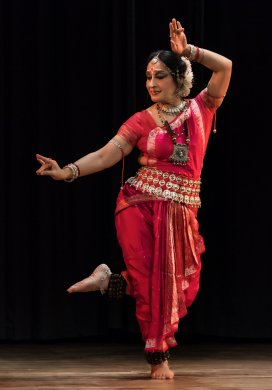 Ranjana Gauhar 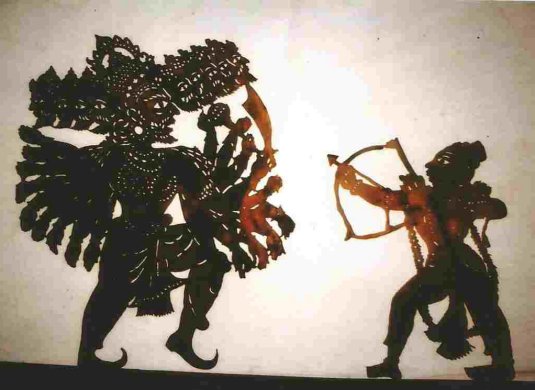 Ravan Chhaya Aniket Pallav Nayak and Biswa Bhusan Champatiray started their dance under the guidance of Guru Somantha Pradhan and Guru Kanduri Charan Behera. They performed Panchabhuta. The evening ended with the most awaited performance by the repertory members of Guru Aruna Mohanty, trained and nurtured under the able guidance of Guru Gangadhar Pradhan. Dynamism, charisma and astounding talent makes Aruna Mohanty one of the finest Odissi dancers. The perfect blend of bhava, bhangi, taala and abhinaya radiate from her performances. She has always kept abreast with contemporary issues, comparing them with happenings from the remote past. Here she presented 'Nari.' Dancers Madhusmita Mohanty, Madhusmita Naik, Biswajit Das, Rudra Prasad Swain, Pratap Kumar Bariki brought her choreography alive. Light design was by Ramesh Jena. According to Aruna Mohanty, Nari is an embodiment of courage and dharma. She traced the journey of Sita, Kunti and Draupadi and drew upon the character of Nirbhaya of the present times. The question she raised was that even the greatest of the great women have had to suffer in this brutish world. They presentation was a kind of eye-opener for the society at large. Vivid portrayal of heart rending scenes created a lump in one's throat. For a warm up before the presentation of Nari, Khamaj Pallavi in taal ektaali prepared the audience on what to expect from the disciples of Aruna Mohanty and they did not belie audience expectation.  Guru Nimakanta Routray and group The bouquet of dance performances was enhanced with Odissi music by Guru Nimakanta Routray of Aalap (Odisha), a notable guru with a masters degree in Odissi vocal from Utkal Sangeet Mahavidyalaya and Sangeet Vaskar from Pracheenkala Kendra, Chandigarh. The tradition of shadow puppet theatre in India is very old and thrives in the states of Odisha, Andhra Pradesh, Karnataka, Tamilnadu, Kerala and Maharashtra. The shadow puppet theatre of Odisha known as Ravan Chhaya, meaning the 'Shadow of Ravan,' is actually the story of Rama. It is named after Ravan as it is believed that Rama, a divine and illuminated being, does not cast a shadow. Ravan Chhaya Natya Sansada, one of the premier shadow puppetry institutions of Odisha, was established in 1982 by late guru Kathinanda Das. The present director and Guru Khageswar Pradhan and Ravan Chhaya Natya Sansada presented an engrossing puppet theatre on the fourth day of the festival. Tapati Chowdurie trained under Guru Gopinath in Madras and was briefly with International Centre for Kathakali in New Delhi. Presently, she is a freelance writer on the performing arts. |